Metal Halide vs LED
13 Reasons LED Wins (especially No. 3)
It’s common knowledge that converting from Metal Halide Lamp (HID) lighting to LED (light-emitting diodes) lighting will save you money. LED stands for “light-emitting diode,” and LED works by passing an electrical current through a semiconductor, which emits light efficiently. The real question is how much money it will save you and why.
Are Metal Halide Lamps Energy Efficient?
Metal halide lights are more efficient than other HID lights but less efficient than LEDs. They produce a wide range of colors and are efficient with cool color outputs. Metal halide lamps use metal halide gas inside the bulb to enhance light efficiency and color quality. In most situations, LED lights are more efficient, and they’re better for other reasons, too. Here, we’ll break down everything that you need to know about the differences between Metal Halide Lights and LED lights. Spoiler alert: LEDs are better. But how much better are they? Read on to find out.

1. Lumens Efficiency
First, we’ll take a look at the average stats of a typical 400-watt metal halide bulb compared to our 150 Watt LED UFO High Bay (this compares a 400-watt MH High Bay to an LED High Bay). Metal halide bulbs suffer from significant lumen depreciation over time, meaning their light output drops well below their initial rating. In contrast, LEDs are designed to maintain their original output much longer, delivering consistent brightness and efficiency throughout their lifespan. This means LEDs provide more reliable illumination compared to metal halide lamps, which lose visibility as their original output diminishes.
400-watt Metal Halide vs LED
- Mean Lumens: 400-Watt Metal Halide – 32000 lm | 150-Watt LED High Bay – 30000 lm
- Efficiency (lm/W): 400-Watt Metal Halide – 70 lm/W | 150-Watt LED High Bay – 200 lm/W
- Fixture Lumens: 400-Watt Metal Halide – 25000 lm | 150-Watt LED High Bay – 30000 lm
Notes:
- Metal Halide Lamp’s efficiency also takes into account 15% additional ballast draw consumption.
- Metal Halide fixture lumens reduced by 15-20%. Omni-directional light sources that use a reflector can lose 25% or more of the lumens produced due to the physics of reflected lumen bounce inside the reflector.
- Metal halide lamps generate a lot of heat. This means a large portion of the energy they consume is converted to heat, and not light.
However, a white paper by the Dark Sky Society rated the mean lumens for a 400-Watt Metal Halide to have an initial light output of 20,500 lumens and a life expectancy to be around 15,000 hours. This paints a much better picture of how HIDs behave in real life because it considers the very real problem of lumen degradation. As you can see, metal halide bulbs start with extremely high lumen output (known as initial lumens). But the key words there are “starts with.”It is not uncommon to lose 20% of those lumens within the first 6 months of use. 36,000 initial lumens are bright.
Unfortunately, you won’t get to enjoy that powerful shine for long. Chances are that within 6 months, your new HID light will be below 30,000 lumens. Metal halides are known to lose their luminescence quickly. At the halfway point of its life, around 4,000 to 10,000 hours, there will already be a lumen depreciation of 50%. But this doesn’t take into account lumen loss due to reflected light. Let us explain. Metal Halide bulbs emit light omnidirectionally. Omnidirectional lights produce light in a 360-degree pattern. To make this distributed shine useful, you need to collect and focus the Metal Halide lumens. You need to add a reflector to do this.
However, there is an inherent problem with the physics of reflected light. A lumen that bounces off the reflector and doesn’t immediately leave and is pointed back at the reflector or bulb itself is a lost light lumen. Any light particle that bounces more than once can be considered lost or unusable.
You can lose as much as 30% of the light in this reflective bounce.
We’ve given you the facts, so now it’s onto the figures. An industrial metal halide high bay, one that is rated at 400 Watts, produces around 36,000 lumens. After 6 months, we would expect the fixture’s effective lumen efficiency to be:
- 36,000 lumens – 20% (initial lumen loss) = 28,800 lumens.
- Lumens lost from reflected (more than one) bounce: 8,640
- Total lumens after 6 months: 20,160
This also does not consider any lenses or shields that the fixture might already have in place, which would decrease lumens even further. We refer to this number as bulb lumens. Figures that take into account lenses or shields on the fixture are called fixture lumens. Now, let’s compare this to an LED light. The light is 100% directional and has 0% reflective lumen loss. It does not need a reflector to gather and focus light. Comparatively, lumen depreciation in LED is minimal and takes much longer to occur. L70 times in LED can exceed 100,000 hours
2. LED’s Superior Operating Life
As mentioned, the expected life of a typical Metal Halide bulb is, at most, 20,000 hours. Some 100-watt metal halide bulbs advertise their expected life to be around 15,000 hours. And in commercial and industrial settings where you’re likely using much more powerful lights, this drop in lifespan is significant. There are several different ways suppliers describe the life of a product.
One of these ways is to measure lifespan via the L70 method. L70 is not a measurement of the end of a light’s life. Instead, it is a measurement of lumen degradation up to 70% of the initial lumens. This measurement does not include external circumstances, like if the driver or ballast, or some other components, were to fail. The life of a Metal Halide bulb is around 15,000 to 20,000 hours.
In comparison, a single LED can last significantly longer than a metal halide bulb, reducing the need for frequent replacements. But, at the light’s half-life, it has already lost 50% of its initial lumens. So, while it’s not necessarily dead, it’s ineffective. And just so you have the full picture, even though the light isn’t producing at its initial lumen output, it still consumes 400+ watts.
3. Efficacy ( lumens/watt ) – Metal Halide Lights vs LED
Efficacy is how efficiently a light source converts watts to visible light. For this blog, we will only compare LED and Metal Halide. But all bulb source efficiencies can be calculated. Understanding efficacy is important to understand why LEDs save you so much on energy costs. Here’s how to calculate lumen efficiency.
- Take the total lumens produced and divide it by the total watts consumed. In the case of Metal Halide bulbs, you will also need to include the ballast draw.
- On average, the total watts consumed by a 400-Watt Metal Halide bulb is around 455 watts (this includes the additional ballast draw). Metal halide lamps also require a significant warm-up period to reach their full operating power, using more time and energy before achieving optimal output, while LEDs reach their operating power instantly and provide immediate illumination.
Calculating lumen efficiency for metal halide: 36,000 lumens / 455 watts = 79.12 lumens/watt. Compare that with our 150-Watt LED High Bay: 30,000 lumens / 150 watts = 200 lumens/watt. That’s over 2X the efficiency of Metal Halide.
Remember the golden energy-saving rule: Efficacy (efficiency) Saves You Money!
Best Sellers: LED Shoebox Lights

90 / 120 / 150 Watt Adjustable LED Shoebox Area Light

180 / 240 / 300 Watt Adjustable LED Shoebox

150 Watt LED Shoebox Area Light

300 Watt LED Shoebox Area Light

80 / 100 / 120 / 150 Watt Adjustable Shoebox Light
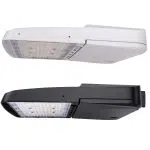
80 / 100 / 120 / 150 Watt Adjustable LED Shoebox
4. LED Energy Savings and Energy Efficiency
Now that you understand efficacy, you have a little more insight into how and why LEDs are energy-efficient lighting. They can produce more lumens with less energy. Converting from metal halide to LED, you’ll end up with brighter light and a lower lighting bill.
Switching to LED lighting can also significantly lower your electricity bill, making it a cost-effective upgrade. We call that a win-win. In the above example, we compared a 400-Watt metal halide bulb with a 150-Watt LED high bay. This showed just how much more efficient LEDs are, but also how much more powerful they are. Here are two practical, real-life examples. The more efficient LEDs become, the fewer LED watts that are required.
For applications in a warehouse, an LED High Bay at 150 Watts that produces 30000 lumens is a terrific option. For applications in a parking lot, a Shoebox Parking Lot Light at 100 Watts will work great, and if you’re looking for a bit more, try the 150-Watt version. The benefits don’t stop with just warehouses. All sorts of project types can benefit from a switch to LEDs. This includes projects from parking lots to baseball fields and marine lighting upgrades. Every type of lighting project can benefit from the improved light, reduced maintenance, and energy savings of LED lights.
Best Sellers: LED High Bays
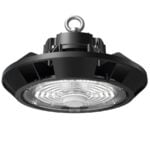
200 Watt Adjustable UFO High Bay
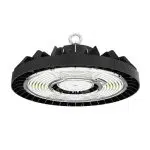
150 / 175 / 200 / 240 Watt Adjustable LED UFO High Bay

120 / 160 / 200 Watt Adjustable UFO High Bay
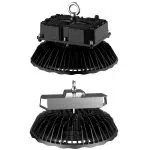
300 Watt UFO High Bay | 45000 Lumens
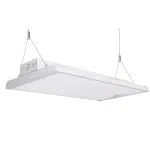
80 / 90 / 105 Watt Adjustable Linear LED High Bay
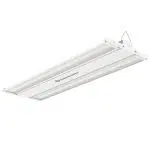
180/240/300 Watt Adjustable LED Indirect High Bay
5. LED Wins with Savings on Maintenance Costs
Far and wide, LEDs are touted as energy-efficient lights that save you a significant amount of money on your electrical bill. However, this is not the only place where LEDs will save you money over metal halide bulbs. An often-forgotten aspect of LED lighting is its low maintenance requirements.
When we discussed lifespan and efficiency, we mentioned that over the life of one LED product, a customer would have to do 5-6 bulb replacements on a metal halide light. Replacement bulbs add up fast, especially when you’re replacing warehouse lighting for a large facility. The higher the installation height, the higher the cost of replacement. If you have a facility equipped with lights, the annual cost of replacing bulbs adds up quickly. The maintenance cost of metal halide lighting is much higher than that of LED lighting, as LEDs require fewer replacements and less ongoing upkeep. The money you save on replacement bulbs admittedly won’t be as much as you save on your energy bills.
However, these low-maintenance lights save you more than just money. They save you and your employees’ time. Employees can delegate their hard work to much more important tasks instead of switching out light bulbs. This will improve overall efficiency and productivity.
6. Quality of Light – LED Has High CRI
When using a light meter to measure a light’s output, it detects lumens. Metal Halide creates visible and invisible (to the human eye) light. This includes UV (Ultraviolet) and IR (Infrared) spectrums, visible to light meters but not to humans. LEDs, on the other hand, don’t produce UV and IR light. It only produces light in the ranges we can see. Like lumens, foot candles are also a measurement of light intensity. One foot-candle is defined as enough light to saturate a one-foot square with one lumen of light.
So, instead of measuring the amount of light that leaves a light source, foot candles measure the amount of light that reaches a surface area. If you compare brand-new Metal Halide lights and LED lights, you’ll likely find that initially, Metal Halide lights produce slightly higher foot-candle readings. Yet, the light produced by the LED seems brighter. Why?
Some of the light detected by the light meter includes undetectable light that we can’t see (UV and IR). LEDs produce only usable, very high-quality light. Another factor that plays into the way we perceive light is accounted for by the CRI. CRI is a measurement of the Quality of Light. On a scale between 0 and 100, 100 is excellent. And LEDs tend to have a high CRI value. LEDs also offer a broad spectrum of color rendering values and adjustable color temperature, which enhances visual clarity and makes them suitable for a wide range of applications. This allows us to perceive color more accurately and helps prevent eye strain and headaches. With LED lighting, you’re choosing quality over quantity and reaping the benefits.
7. Photopic vs Scotopic Lumens
Photopic and scotopic lumens are a technical discussion of how people see visible light (scotopic) and how light detection devices, like light meters, detect and measure light (photopic). The human eye uses rods and cones to detect light and color. Rods are responsible for night vision but can’t detect color. Different light intensities can affect how both the human eye and light meters perceive and measure illumination.
The key takeaway: human eyes read light in a very different way than light meters. To account for these differences, light scientists have developed a new way to measure and compare light called S/P Ratios. S/P ratios compare light from different sources and measure how light appears: scotopic versus photopic. Using a scale between 0 and 3 creates a level playing field between different light sources.
The S/P factor for LEDs is always higher than that for Metal Halide lights. So, in layman’s terms, what does this mean? Let’s discuss this in terms of extremes, LED versus High-Pressure Sodium. For this example, we will use an average S/P ratio associated with LED, which is 2.0.
Best Sellers: Shop Lights

200 Watt Adjustable UFO High Bay

30 / 40 / 50 Watt Adjustable Shop Strip Light | 4 Foot

60 / 70 / 80 Watt Adjustable 8 Foot Shop Strip Light
8. LEDs Work Great with Photocells, Motion Sensors, and Other Controls
LED has two features that metal halide just can’t compete with.
- Instant On / Instant Off
- Dimming
While alone, these features are great when matched with lighting controls, they turn into a smart appliance that’s bright when needed and energy-saving when it’s not. Motion sensors detect movement. With LED, the fixture can increase brightness when movement is detected. It happens instantly. After a specified period, if no additional movement is detected, the light turns off or dims. Because LEDs are dimmable, this isn’t a problem. Fixtures can be set to dim to certain percentage levels. The dimmer the level it’s set to, the more energy you save. Metal Halide suffers from extremely long strike times. Strike times are the time it takes for the bulb to get to full brightness once it’s turned on.
Metal Halide can take up to 30 minutes to get to full brightness. Even worse, if you turn it off, it needs time to cool down. Then you go through the long warm-up time again. Metal halide lights require special equipment for dimming, and adjusting the voltage input during dimming can negatively impact their performance and lifespan. Motion sensors are not a good match using Metal Halide.
Now, it is extremely common to see lighting controls matched with LED. Here’s a basic rule – nothing saves energy better than a dimmed light or one that’s turned off. So, when you’re doing the calculation of energy savings when converting from Metal Halide to LED, consider adding one of the available light controls. The energy savings from 400 Watts Metal Halide to 10 Watts LED (100 Watts LED dimmed to 10%) are incredible.
9. Cycling ( Instant On and Off )
Metal halide is known for its notoriously long cycling times. Turning on the lights and waiting for full output can take as much as 30 minutes. Metal halide lights have the longest warm-up period among common lighting types and require significant time to reach full operating power. Even worse, if they accidentally get turned off, the lights need time to cool before the long, lengthy start-up time can begin.
With LED, it’s instant on, instant off.
10. Dimming
Metal Halide can be dimmed using special magnetic or electronic ballasts. A magnetic ballast is required to regulate the electrical current and enable dimming in metal halide lighting systems. The presence of metal halide vapor inside the lamp is essential for producing light, and changes in voltage affect the characteristics of the light output. Dimming can also reduce the life of the bulb. With LED, there are 2 types of dimming. In a commercial and industrial space, 0-10V or 1-10V dimming is the standard. In this dimming system, small voltages are sent to the light as 0 to 10V. 1 volt tells the light to be 10% bright, and 9 volts signals the light should be 90% bright. Dimming does not degrade or shorten the life of the light. It will lengthen the life of the LEDs since they are running at less than full capacity.
11. UV ( Ultra Violet ) and IR (Infrared)
Metal Halide produces both UV and IR spectra (non-visible). Metal halide lamps emit both UV radiation and infrared radiation, which can be harmful or require filteringWith LED, no UV or IR is produced.
12. Heat Emissions
Metal Halide produces a lot of heat. A significant amount of energy it consumes produces heat. The heat generated by metal halide lamps can increase the load on a facility’s HVAC system, leading to higher cooling costs. You should never touch an operating metal halide bulb; it will burn you. LEDs are significantly more efficient, utilizing almost all the energy they use to produce light. However, they do get warm and sometimes hot, but nowhere near the heat produced by metal halide. You will find that after you convert from metal halide to LED indoors, your HVAC system will run less often.
13. Available Rebates from Your Utility Company
Electricity demand grows every day, but this is a finite resource. There’s only so much energy that a power company can produce each day. To combat this ever-growing need for electricity, power companies are offering rebates to customers who make energy-efficient upgrades. An easy way to earn a rebate is to convert from Metal Halide to LED. Every utility company runs its rebate program.
But in general, there are some consistent processes and guidelines. For the most part, utility companies offer both prescriptive and custom rebate options. A prescriptive rebate specifies which LED fixtures can replace a metal halide fixture. A custom rebate is for those exceptions not covered by prescriptive conditions.
LED (light-emitting diode) lights need to be Design Lights Consortium (DLC) Qualified. This is a universal symbol of efficiency and performance.
It can be thought of as the equivalent of Energy Star for consumer products.
It tells the customer the light has passed a specific lighting standard.
These rebates help reduce the initial cost of installing LED lights and will speed up the payback period. Rebates aren’t the only incentive to switch to LED lighting, but they sure are a good one.
With Metal Halide, there are no rebates. Sorry.
First Step to Start a Conversion to LED?
Without a doubt, the best first step is to ask us to work out a free lighting plan for you. Converting your facility (indoors or outdoors) to LED starts by deciding how many foot candles you need. Supply us with your project information, and we’ll take it from there. And we do lighting plans for free for our commercial and industrial customers.
LED lighting is especially beneficial for commercial buildings due to its energy efficiency and suitability for large indoor spaces. Why? We know that a lighting plan will be the roadmap to a successful conversion to LED. And we want your project to be a success too!





